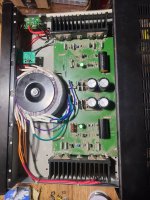Cumbb,
What do you think of Jean Hiraga's opinion about the great musicality of TO3 transistors? (Cf the french magazine " La Revue du son")
What do you think of Jean Hiraga's opinion about the great musicality of TO3 transistors? (Cf the french magazine " La Revue du son")
TO-3 enclosures are the most unmusical. They have the worst construction in terms of current and flow: both the shape and the diameter, often also the internal connections of emitter and base. In addition, the housing is often made of a mixture of materials. And also the connection of the (mostly) collector by screw. Most users also connect to current by means of two screws: 2 times washer - nut - screw - washer - thus also a current loop, and a summation of further signal modulating materials and transitions)-;
Jean was wrong about TO-3 transistors)-;
And practically: all the ones I heard, even compared to the same ones in the TO-247 cases, are among the worst sounding: noisiest, most bumpy, most covered, most contour and colourless.
Sorry)-;
Jean was wrong about TO-3 transistors)-;
And practically: all the ones I heard, even compared to the same ones in the TO-247 cases, are among the worst sounding: noisiest, most bumpy, most covered, most contour and colourless.
Sorry)-;
Last edited:
what would be an emmiter resistor value to match those devices?I would bid adieu to TO-247, TO-3P and larger designs. The best in this size I heard was NJW3182. But almost all TO-220 were clearly more focused, cleaner, more fluid, more accurate: more elaborated.
I would currently recommend proving the TIP transistors in 220 guise;-)
Start with the installed 0,22 Ohm. Then I would double the value: 0,47 - to get an impression of sound change, to get the direction.
On a side note, but regarding Hiraga's Classe A - one of the best complex half-wave symmetric complementary transistor push-pull amplifiers - The connection of the amplifiers:
... and please replace the fat copper bars with thin copper wires, max. 1 mm diameter. And throw out this terrible MKP also - without replacement!-)
... and please replace the fat copper bars with thin copper wires, max. 1 mm diameter. And throw out this terrible MKP also - without replacement!-)
Attachments
- Home
- Amplifiers
- Solid State
- Rotel recommendations for upgrades?
![DSCN0304[1].JPG](/community/data/attachments/1085/1085150-6c73b9c33d8c348adcc86eec1a8bd061.jpg?hash=bHO5wz2MNI)
